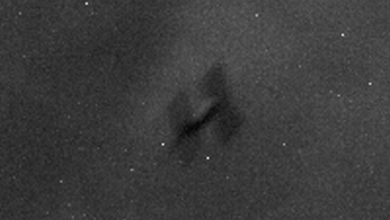Brand new black hole image will blow your mind

At the heart of our Milky Way galaxy lies a giant.
It’s a massive black hole, dubbed Sagittarius A* (pronounced “Sagittarius a star”), weighing as much as 4.3 million suns. After taking an unprecedented image of the object in 2022, astronomers have now captured a remarkable new view of the black hole, revealing its powerful, twisting magnetic fields. The scientists captured the black hole in polarized light, which involves using a filter to view different characteristics of the distant object. (Magnetic fields are created by moving, charged particles.)
“What we’re seeing now is that there are strong, twisted, and organized magnetic fields near the black hole at the center of the Milky Way galaxy,” Sara Issaoun, a NASA Hubble Fellowship Program Einstein Fellow at the Center for Astrophysics Harvard & Smithsonian who co-led the research endeavor, said in a statement.
NASA scientist viewed first Voyager images. What he saw gave him chills.
Black holes harbor so much gravity that not even light can escape — because they’re almost unimaginably dense, massive objects. The more mass an object has, the stronger its gravitational pull. If Earth was (hypothetically) crushed into a black hole, it would be under an inch across. So you might wonder, how can we see a black hole if it doesn’t emit any light?
Although we can’t see the actual object, we can see the matter — intensely hot gas — swirling around a black hole, called an “accretion disk.” Some of this material inevitably falls into the black hole, never to return; much of it gets spewed back out into the cosmos, because black holes aren’t efficient consumers of galactic material. Where the light ends at the center of the image is the point-of-no-return, called the “event horizon.” That’s the final boundary between space and the black hole.
Mashable Light Speed
In the orange-colored accretion disk, those vivid lines show the twisting structure of the magnetic fields in the donut-like disk. Ultimately, these magnetic fields can propel jets of matter out of the black hole’s swirling disk of gas.
“By imaging polarized light from hot glowing gas near black holes, we are directly inferring the structure and strength of the magnetic fields that thread the flow of gas and matter that the black hole feeds on and ejects,” Angelo Ricarte, a Harvard Black Hole Initiative Fellow who also co-led the research, said in a statement.

The latest image of Sagittarius A* reveals the black hole’s twisting magnetic fields.
Credit: Event Horizon Telescope (EHT) collaboration
The new black hole research was published on March 27 in the peer-reviewed science journal The Astrophysical Journal Letters.
Importantly, the astronomers found that both Sagittarius A* and the black hole at the center of the galaxy M87 — an object 1,000 times more massive than Sagittarius A* — are similarly built: They both contain the same type of magnetic structures in their swirling disks, even though there’s a giant size difference. This might be a common feature of most black holes — places still mysterious to us, but gradually growing less opaque.
To capture rare images of black holes (only these two black holes have been imaged), scientists use the Event Horizon Telescope (EHT), which is composed of radio telescopes all around Earth. Working together, they create a planet-sized array amounting to a virtual telescope. Expect these black hole images to grow more detailed and impressive in the coming years. Scientists are adding more telescopes to the EHT, called “The Next Generation Event Horizon Telescope,” with the ability to make real-time movies of these cosmic behemoths.





